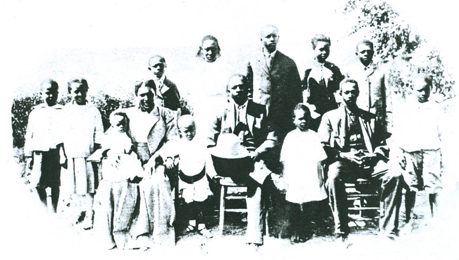Blackdom settlement a tribute to two men’s courage, hope

In 1896, the Civil War was 30 years a memory. But for black Americans, particularly in the South, the freedom of which they’d so long dreamt was not manifesting.
Racial oppression continued to dominate society, and their efforts to obtain land and gainful employment were often thwarted. Not only were they unable to achieve prosperity, many could barely provide for their families.
A journey of nearly 2,000 miles, on foot and through some of the country’s harshest conditions, seems like a last resort. But with the promise of a better future on the other side, it was worth every step to the founders of Blackdom, N.M.
Georgia schoolteachers Francis Boyer and Dan Keyes made that journey in 1896, inspired by stories of unexplored and unclaimed spaces just waiting to be settled related to Boyer by his uncle, Henry.
Henry, a free man and member of the Missouri Volunteer Infantry, had been deployed to the Southwest as a wagon driver during the Mexican-American War. In New Mexico, he told his nephew, anyone could obtain 160 free acres of land simply by settling it. And there was land as far as the eye could see.

Boyer and Keyes had a vision: A settlement of black people. A farm for every family. A means to support themselves and thrive. And a community in which they could live their lives away from the prejudice that plagued them.
The two walked through punishing heat and over dangerous terrain. They suffered humiliation along the way, forced on multiple occasions by white men they encountered to dance and sing while having bullets fired at their feet. But they kept their vision at the forefront of their minds. And upon reaching New Mexico, they began the process of making it a reality.
Taking what work they could find in the Pecos Valley in order to save money, Boyer and Keyes quickly learned a harsh truth about their new homeland: Water was hard to come by. With cattlemen laying claim to what surface water could be found, farmers scraped for their share. But a discovery was soon made that changed all that – artesian aquifers. And the settlers came pouring in.
Recognizing the opportunity they’d been searching for, Boyer and Keyes relocated to an area several miles west of Hagerman.
Boyer dug an artesian well and began producing hay and apples. And, now convinced of their settlement’s potential, he also began to spread the word about Blackdom.
Advertising extensively in southern newspapers, Boyer encouraged black Americans to leave their struggles behind and join him in a place where they could find prosperity and peace. An estimated 300 people answered the call and set about making Blackdom their own.

It wasn’t always as easy as it should have been. Many whites in the area objected to the proximity of the settlement, with a September 1903 edition of the Artesia Advocate proclaiming, “If the colonists work hard, behave themselves, and do exactly what their white neighbors want them to do, all will be well. Otherwise, otherwise.”
But the citizens of Blackdom had undergone much worse. They reached out to their white neighbors in friendship, inviting them to participate in community events and giving concerts in nearby towns to help raise funds for their endeavors.
They were able to erect a community center that tripled as a church and school, buoyed by supplies from the Greenfield School District, whose motivation was reportedly to ensure the schools in the surrounding area remained segregated. They established a post office. Along with homes, stores, a hotel, a blacksmith shop, and a church building sprang up.
For a while, all was as Boyer and Keyes had hoped and more. The affordability of the settlement, however, was short-lived.
The cost of drilling an artesian well such as the inaugural one established by Boyer was $4,000, and most of Blackdom’s residents could scarcely afford the nearly $200 required to dig a shallow well. Their remote location, a necessity in order to maintain a civil relationship with their neighbors, was too far from the Pecos River and other nearby water sources to make them a viable means of sustaining the settlement.
Blackdom simply could not survive.
Sadly right around the time it achieved legal incorporation, Blackdom began to fade. Its families dispersed into communities in the surrounding area and beyond, and its buildings were dismantled or left to weather away.

The settlement’s quaint church notably survived and was relocated to Cottonwood, where it was renovated and converted into a home in 1985 by an Artesia couple. That couple later passed it on to relatives.
The home – which stands on Funk Road north of town – and a historical marker at the rest area on U.S. 285 between Artesia and Roswell are all that remain today to remind area residents and travelers of Blackdom.
But the bravery, hope, determination and courage of Boyer, Keyes and its residents live on as a testament to the pioneering spirit and the belief that a better world was on the horizon.




